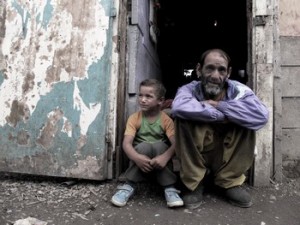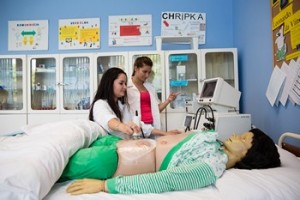It is a cool autumn day in eastern Slovakia, and Robert Rybar and his sons are stacking scrap wood. Winter is coming and fire is the only way to heat their small shanty.
“It’s good wood, and it’s cheap,” Rybar says.
Just steps away is a massive pile of garbage; there has been no pickup for three weeks. The opening to a septic system where a child drowned two years earlier is still not covered. Rybar, a 42-year-old father of seven, is a rarity in Budulovska, an informal Roma settlement in a field just a few hundred meters outside the town of Moldava nad Bodvou: he has a job. In fact, of the 800 people who live in Budulovska, he is the only one working full time, laboring as a maintenance man at the nearby U.S. Steel plant.

Jobs are scarce in the Budulovska settlement of Moldava nad Bodvou. Although a government program to promote vocational education is not designed to help Roma in particular, they could be among its prime beneficiaries. Photo by Karol Horvath.
Underlying the unemployment crisis in Slovakia’s Roma community is a massive education gap that sees Romani-speaking students trailing their peers by some four full years of schooling on average. Prime Minister Robert Fico’s left-leaning government is now emphasizing vocational education and increased collaboration between secondary schools and employers. Minority integration is almost certainly not the goal of the effort, but with joblessness much worse in the Roma community – whose young people are already disproportionately diverted into vocational programs – the shift could have the unintended benefit of bringing more Roma into the labor force.
On 9 January the Slovak government approved a 26 million euro ($30 million) proposal to implement its own version of dual education systems in place in Germany, Austria, and Switzerland. Targeting vocational secondary school students, the plan calls for 40 percent of study time to be devoted to classroom education and 60 percent to work experience with firms that may opt to hire the students after graduation.
In exchange, businesses big tax breaks – for example, a write-off of 3,200 euros for each student they hire and pay for more than 400 hours of work – and potential long-term employees who are already trained. The proposal may yet face changes when it goes before parliament, but with an outright majority in the legislature, Fico’s Smer party looks set to pass and implement it by the start of the school year in September.
“We want to do our utmost to inspire greater interest in vocational education on the part of students and to enable employers to participate directly in the education of young people and to hire them,” the prime minister told reporters 9 January.
The Fico government is not noted for its progressive human rights stance, and any benefit to the Roma community from this policy is likely to come by accident. In fact, Fico and allies have done much to sideline the country’s rights watchdog, Ombudswoman Jana Dubovcova, including bottling up in a parliamentary committee her report on a violent police raid on the Budulovska settlement. Rather, Fico hopes to eat into an unemployment rate that consistently hovers around 14 percent.
Still, as the policy aims to better educate those now finishing school with a lack of marketable skills, and as a disproportionate number of such people are Roma, it could boost integration efforts as well as the economy.
“A lot of young Roma in Slovakia leave school early because of the possibility to earn [money from] small-scale employment at the municipal level, so called-activation work,” said Beata Olahova, a Slovak Rom who oversees grants for the Roma Education Fund (REF) in Budapest.
Olahova said dual education could lead to “better results” for Roma, potentially offering broader employment opportunities as well as higher pay and benefits than activation workers get.
In Slovakia, monthly pay for activation work averages 63 euros, the equivalent of 30 hours per month at minimum wage – something seemingly within reach for vocational work. As the REF’s Tom Bass points out, “The human rights argument for integration doesn’t really get heard anymore, so now it’s also about making the economic argument.”
The economic case is convincing. A 2006 study (pdf) by researchers at the Hungarian Academy of Sciences’ Institute of Economics showed that a secondary school graduate contributes 70,000 euros more to Hungary’s national budget than someone whose education ended with primary school. A vocational school graduate provides a 55,000 euro benefit. At that rate of return, supporters of the Slovak program say that even a relatively modest government investment in the effort could pay off handsomely.
In Slovakia, 60 percent of non-Roma have a full-time job, according to the Slovak Finance Ministry’s Financial Policy Institute (IFP). For Roma, the figure is below 17 percent. If employment rates in the Roma community were comparable to those of everybody else, the nationwide jobless rate would drop from 14 percent to 11 percent.
In theory, improved vocational training for Roma should lead to more jobs and higher pay. With Roma accounting for an estimated 8 percent of the population, this would have a major effect on the Slovak economy, boosting consumption, tax revenues, and all sorts of things Fico presumably favors. But such thinking still does not take into account old-fashioned racism.
“One of the reasons of exclusion of the Roma from the labor market is missing skills and low levels of education,” the IFP wrote in a recent report. “But the extensive discrimination on the labor market also prevents higher employment.”
To test for workplace bias, IFP used six comparable fictitious CVs – half with names that typically indicate Roma ethnicity, half without – to apply for real jobs between July and September last year. Some 40 percent of the non-Roma applications resulted in an invitation for an interview, compared with less than 18 percent of Roma applicants. Just 37 percent of Roma applicants received any response, compared with 69 percent of the rest. The divide was even more extreme among the jobs that required higher education.

Recipients of scholarships from the Roma Education Fund can study at a school for health care in Roznava, Slovakia. Photo courtesy of the REF.
There are other problems with the vocational education plan’s ability to aid Roma, not to mention others, entering the workforce. While Slovakia’s GDP grew by 50 percent in real terms from 2003 to 2013 (compared with the EU average of 11 percent), the country had the fifth highest unemployment rate in the EU at the end of 2014. In other words, rapid economic growth did not translate into the rapid creation of new jobs.
According to a study by VUB Bank, over the past decade Slovakia’s economy needed to grow by at least 2.4 percent per year to generate new jobs. In Poland that number is 2.2 percent and in the Czech Republic just 0.7 percent. The discrepancy has more than one cause, but much of it comes from Slovakia’s disproportionate reliance on certain types of manufacturing. Improving technologies mean that increased output does not necessarily correlate with hiring workers.
The degree to which the dual education program will emphasize manufacturing, as opposed to service industry jobs, could profoundly influence its success. (It appears to be doing just that, with firms such as Miba Steeltec, Pankl Automotive Slovakia, Matador Automotive Vrable, and Bauer Gear Motor Slovakia taking part in a pilot version.) Though the hope is that an even more skilled workforce would draw new companies, the program is still predicated on students being trained by existing employers, some of whom look set to hire fewer new workers as times goes on. It also does nothing to account for the kind of hard-to-regulate discrimination implied by the IFP study. Yet another question is whether the policy will, in practice, reach into the rural areas where where many of Slovakia’s Roma live.
The REF divides its priorities into early childhood education, dropout prevention, and high school scholarships and tutors. Among its secondary school partners are two vocational education programs that notably focus on the service sectors, training workers for the health care and hospitality industries.
While most experts on Roma education would be happy if today’s non-graduates could become tomorrow’s vocational-skill graduates, the dual education policy does little to address the social separation many see as key to the education gap.
“It’s like a snowball: if [Roma children] live in a segregated settlement they don’t go to preschool, then when they get older they are like foreigners in the school,” said Agnes Horvathova, director of the Roma House civic association in Bratislava and a Rom herself. “We are trying things that were common 30 years ago – 100 percent of Roma children were in preschool before 1989.”
Horvathova also assesses a share of blame to Roma parents for not emphasizing the value of education.
Back in Budulovska, Irma Horvathova (no relation to the Roma House leader) is also an advocate of getting kids into an educational setting as early as possible. She runs a small community center out of a shipping container and leads Montessori-style kindergarten classes.
“Twenty years ago things were completely different,” says Horvathova, a Roma mother of three. “Now children are being raised with hatred from an early age. They are raised to have no relationship with ‘the other.’ ”
Benjamin Cunningham is a writer in Prague and a correspondent for The Economist. Karol Horvath is a photographer in Slovakia. This article was originally published on Transitions Online.
Tags: Adult education, Civil society, Development, Financing, Minorities, Policy, Roma, Students
